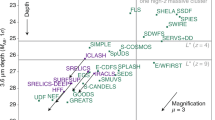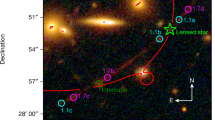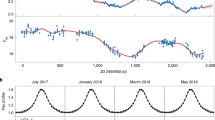Abstract
A RELATIONSHIP between redshift and the angular size of radio sources, particularly quasi-stellar sources, has been sought with limited success for some time. Miley1, for example, observed 72 quasi-stellar sources at 408 MHz and found that those with flat spectra and large redshift had on the average the highest fringe visibility. Bash2, however, concluded from observations of 234 radio sources at 2,695 MHz that while fringe visibility was related to spectra, no significant relation to redshift was evident.
This is a preview of subscription content, access via your institution
Access options
Subscribe to this journal
Receive 51 print issues and online access
$199.00 per year
only $3.90 per issue
Buy this article
- Purchase on Springer Link
- Instant access to full article PDF
Prices may be subject to local taxes which are calculated during checkout
Similar content being viewed by others
References
Miley, G. K., Nature, 218, 933 (1968).
Bash, F. N., Astrophys. J., 152, 375 (1968).
Cooper, B. F. C., Price, R. M., and Cole, D. J., Austral. J. Phys., 18, 589 (1965).
Seielstad, G. A., Astrophys. J., 147, 24 (1965).
Hogg, D. C., Macdonald, R. G., Conway, R. G., and Wade, C. M., Astron. J., 74, 1206 (1969).
Wade, C. M., Pub. Nat. Radio Astron. Obs., 1, 99 (1961).
Macdonald, G. H., Kenderdine, S., and Neville, A. C., Mon. Not. Roy. Astron. Soc., 138, 259 (1968).
Mackay, C. D., Mon. Not. Roy. Astron. Soc., 145, 31 (1969).
Ekers, R. D., Austral. J. Phys. Astrophys. Supp. No. 6 (1969).
Hoerner, S. von, Astrophys. J., 144, 483 (1966).
Hogg, D. E., Astrophys. J., 155, 1099 (1969).
Clark, B. G., and Hogg, D. E., Astrophys. J., 145, 21 (1966).
Anderson, B., and Donaldson, W., Mon. Not. Roy. Astron. Soc., 137, 81 (1967).
Clark, B. G., and Miley, G. K., Astrophys. Lett., 4, 207 (1969).
Mathews, T. A., Morgan, W. W., and Schmidt, M., Astrophys. J., 140, 35 (1964).
Burbidge, G. R., and Burbidge, E. M., Nature, 222, 735 (1969).
Petrosian, V., Astrophys. J., 155, 1029 (1969).
Rees, M. J., and Setti, G., Nature, 219, 127 (1968).
Christiansen, W., Mon. Not. Roy. Astron. Soc., 145, 327 (1969).
Author information
Authors and Affiliations
Rights and permissions
About this article
Cite this article
LEGG, T. Redshift and the Size of Double Radio Sources. Nature 226, 65–67 (1970). https://doi.org/10.1038/226065a0
Received:
Revised:
Issue Date:
DOI: https://doi.org/10.1038/226065a0
This article is cited by
-
Evidence for evolution as support for big bang
Journal of Astrophysics and Astronomy (1997)
-
The cosmological deceleration parameter estimated from the angular-size/redshift relation for compact radio sources
Nature (1993)
-
Cosmological tests fail to confirm generally accepted model of the universe
Radiophysics and Quantum Electronics (1993)
-
Evolution of radio structure in quasars: a new probe of protogalaxies?
Nature (1988)
-
Physical constants and evolution of the Universe
Astrophysics and Space Science (1987)
Comments
By submitting a comment you agree to abide by our Terms and Community Guidelines. If you find something abusive or that does not comply with our terms or guidelines please flag it as inappropriate.



